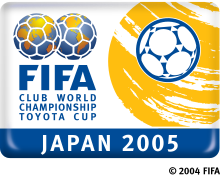2005 FIFA Club World Cup
| FIFA Club World Championship Toyota Cup Japan 2005 | |
|---|---|

FIFA CWCTC 2005 official logo
|
|
| Tournament details | |
| Host country | Japan |
| Dates | 11 December – 18 December |
| Teams | 6 (from 6 confederations) |
| Venue(s) | 3 (in 3 host cities) |
| Final positions | |
| Champions |
|
| Runners-up |
|
| Third place |
|
| Fourth place |
|
| Tournament statistics | |
| Matches played | 7 |
| Goals scored | 19 (2.71 per match) |
| Attendance | 261,456 (37,351 per match) |
| Top scorer(s) |
(2 goals each) |
| Best player |
|
| Fair play award |
|
The 2005 FIFA Club World Championship Toyota Cup was the second edition of the FIFA Club World Championship, and the first held after by the merger between the Intercontinental Cup and the FIFA Club World Championship (which had been played in a pilot edition in 2000 but later discontinued).
The football tournament was held in Japan from 11 December to 18 December 2005 and won by Brazilian club São Paulo.
The 2005 tournament was created as a merger between the Intercontinental Cup and the earlier FIFA Club World Championships. The previous of these had been running as an annual tournament between the champions of Europe and South America since 1960; the latter had undergone just one tournament, the 2000 FIFA Club World Championship. The 2001 tournament had been cancelled when FIFA's marketing partner ISL went bankrupt. To celebrate the marriage between the two competitions, a new trophy was introduced by FIFA.
As a result of this merger, the tournament was conceived as being smaller than the original Club World Championship, which had lasted two weeks, yet building on the one game format of the Intercontinental Cup. Six clubs were invited to take part in the tournament, one representing each regional football confederation. The competition's name, which was the simple union between the name of the two previous merging competitions, was evidently too long, and was going to be reduced the following year, becoming the FIFA Club World Cup.
The competition was a knockout tournament so each team played two or three matches. The champions of the four "weaker" confederations played in the quarter-finals; the losers played in a fifth place play-off. The winners were then joined by the European and South American champions in the semi-finals; the losers played in a third place play-off.
...
Wikipedia
